Site menu:

May 2012 Newsletter
Little Terns at Gronant
April Bird News.
Forthcoming Events.
Latest Newsletter.
Little Terns at Gronant
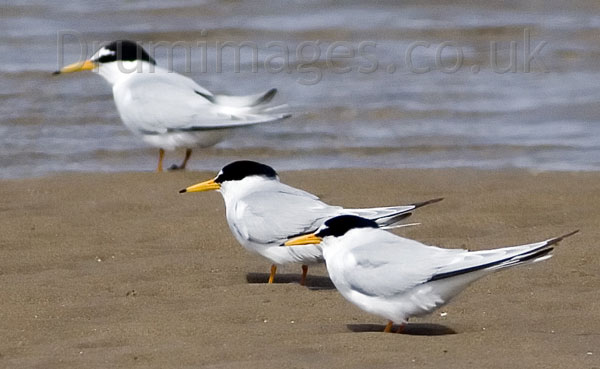
May sees the return of the Little Terns to Gronant having spent the winter off West Africa. Gronant is the only Little Tern colony in Wales and one of the largest and most productive in the UK, to a large extent this is due to the team of wardens and volunteers who protect the colony from predators in all weathers from May to August. This is important conservation work and as usual we are appealing for volunteers to help us, just an hour or two per week would be a help, more even better. Please ring the Denbighshire Countryside Service (01745 356197) if you want to volunteer or need further details, or just turn up at Gronant during the breeding season to see what is involved - see the Gronant Site Guide for more details both of Gronant itself and the birds to be seen in the area.
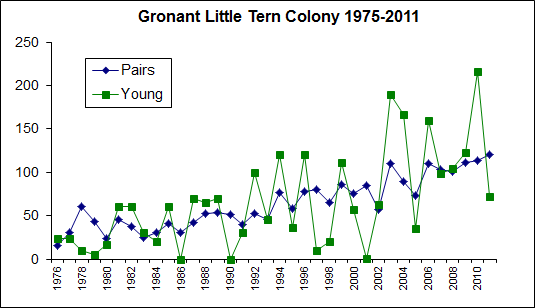
Little Terns are said to be not particularly site faithful, but there has been little sign of that at Gronant over the years with a steady rise in breeding pairs and relatively little year to year variation in numbers indicating the same birds are returning year after year. What does vary is the number of young successfully fledged which is typical of any Little Tern colony with weather, height of tides, predation and human disturbance all potentially having a negative effect on breeding success. 2011 was a more difficult season than most with a combination of bad weather and a pair of persistent Kestrels causing a large drop in young fledged compared to the record breaking year of 2010. But the past 10 years have been largely good ones with only two years where numbers fledged were significantly below an average of one per pair whereas for four years numbers fledged per pair were way over one (e.g. 1.9 in 2010). To sustain numbers it has been calculated by the RSPB that the average young fledged per pair has to be 0.66 whereas the long term average at Gronant is actually spot on 1.0, which means we can expect the numbers of pairs to carry on increasing for a long time yet.
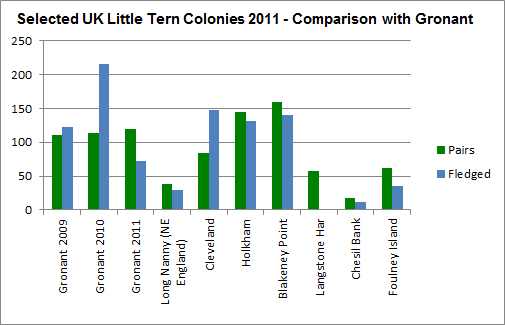
1. Peter Milner & Jonathan
Fleming, Little Tern Report Gronant 2011, Denbigshire County Council.
2. Table showing 2011 Breeding Success of selected UK Little
Tern Colonies received from DCC Countryside Services with thanks.
3. Denbighshire County Council,
Little Tern Report, GRONANT 2009, Emma Thomas, Owen Chamberlain and
Sally Conyers.
4. The Migration Atlas, BTO, 2002.
5. Cramp & Simmons, Birds of the Western Palearctic, DVD
edition BWPi, 2006.
See also Gronant Little Tern article
from 2011 - Click Here.
Richard Smith (Gronant Voluntary
Warden).
Top of Page
April Bird News
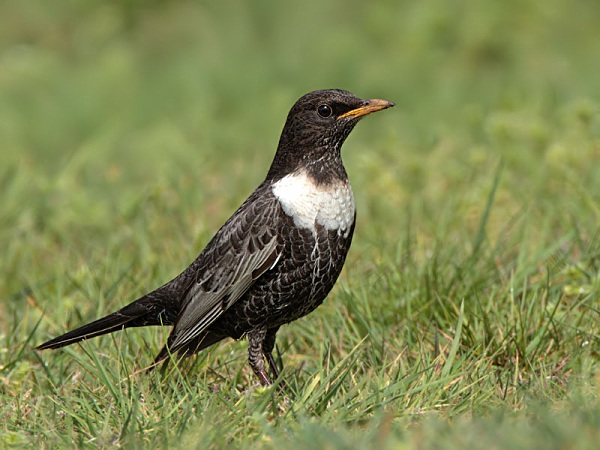
| Species | 2012 | Location (2012) | 2011 | 2010 |
|---|---|---|---|---|
| Sand Martin | 28th Feb | Leasowe Lighthouse | 12th March | 18th March |
| White Wagtail | 8th March | Leasowe Lighthouse | 11th March | 12th March |
| Wheatear | 9th March | Leasowe Lighthouse | 13th March | 10th March |
| Swallow | 17th March | Red Rocks | 20th March | 18th March |
| Willow Warbler | 20th March | West Kirby | 16th March | 19th March |
| Whitethroat | 1st April | Hoylake | 8th April | 7th April |
| House Martin | 4th April | Burton Mere Wetlands | 25th March | 30th March |
| Cuckoo | 14th April | Leasowe Lighthouse | 20th April | 10th May |
| Swift | 26th April | Leasowe, Burton, West Kirby and Hilbre | 17th April | 19th April |
The first is the 'Ashy-headed Wagtail' at Burton Mere Wetlands on the 18th and 19th. For those that don't realise this is one of several races of the continental from of Yellow Wagtail, most of which have dark heads, unlike the British race which has a yellow head. The 'Ashy-headed' is usually found in Italy. The problem is that there are many intermediates and much variation within the races so it is usually difficult to be certain which race a particular bird is from. Despite this particular bird being identical to 'Ashy-headed' (M flava cinereocapilla) in my Collins Bird Guide and the experienced birders who actually saw the bird being certain of its ID expert opinion has it that it is not an 'Ashy-headed' but some intermediate form, although their opinion stems from looking at just one 'record shot'. I understand better photos of this bird were taken so it will be interesting to see what the final opinion of the rarity panel is.
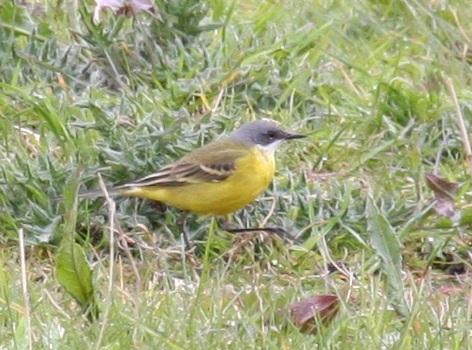
The second record is of six White Storks. This is a pretty remarkable record, particularly for this side of the country, but they were obviously wild birds. They were probably the ones first seen on April 17th in Worcestershire. There was a report on Bird Guides put out on the 23rd of six in a field by Holywell the previous day (22nd), it must have been these which were subsequently seen and photographed flying over Llandudno on the 23rd by none other than Alan Davies (of the biggest twitch fame - see photos on www.thebiggesttwitch.com), these were flying west (i.e. away from Holywell direction) then flew NNW. Next I received an email late on the 25th from a birder saying that some non-birding friends of his had seen several large heron type birds in a field at Frankby on the 24th, which they subsequently confidently identified as White Storks (they had no knowledge of the possibility of these birds being in the area so no reason to be expecting them to be White Storks). Unfortunately these birds were not present the next day. Just out of interest six turned up in Oxfordshire in late April.
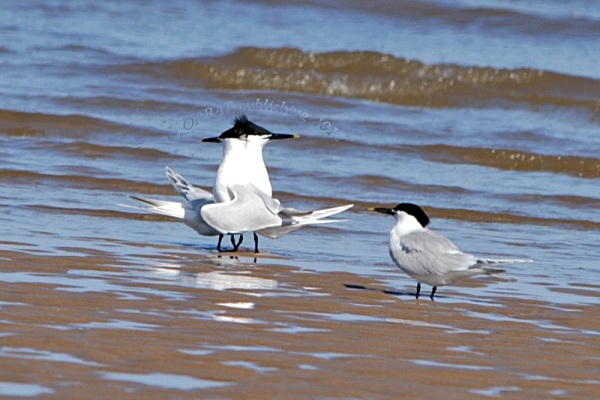
Migration was also taking place out to sea and included good movements on the 17th with large numbers of auks (including at least 570 Guillemotts) with 100 Gannets and 150 Sandwich Terns off Hilbre the following day. The largest number of Little Gulls recorded were 65 past Hilbre on the 6th.
After disappointing spring tides since April last year we at last had a high tide covering the marsh on the 8th and 9th, the highlight being 8 Short-eared Owls on both dates. Other good birds included five records of single Ospreys overhead and the long staying Great White Egret and Spoonbill.
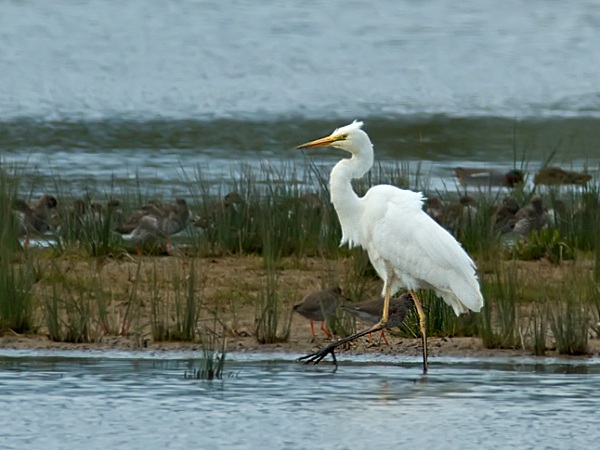
What to expect in May
The spring migration will continue well into May and we should see Cuckoos, Hobbies, Yellow Wagtails, Whinchats and Whimbrels among others, and hopefully a Wood Warbler or two. Last May we had exceptional numbers of migrating Dunlin and Ringed Plover along north Wirral shore, and any waders we see are likely to be in full summer plumage with Spotted Redshanks, Bar-tailed Godwits and Grey Plovers looking particularly gorgeous.
Any strong westerly will bring in good numbers of seabirds in to our coast, certainly terns and Gannets but also auks, Manx Shearwaters and may be an Arctic Skua or two.
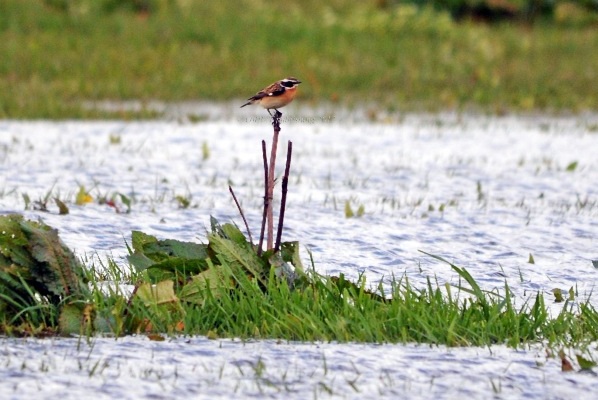
Forthcoming Events
May Highest Spring Tides (Liverpool)
Also
see Tides
page.
6th May, 11.48hrs (BST), 9.7m.
7th May, 12.36hrs (BST), 9.8m.
8th May, 13.25hrs (BST), 9.7m.
Forthcoming Events
Organised by the Wirral
Ranger Service , Flintshire Countryside Service and/or the
RSPB:
All these events and walks have bird interest, even those not
advertised specifically for birdwatching. No need to book for these
events unless specified - please check below.
Also see 2012 Events Diary.
Meet at Burton Mere Wetlands Car Park, off
Puddington Lane, Burton,
Cheshire, CH64 5SF.
Get down to Burton Mere Wetlands and help us celebrate our first ever
International Dawn Chorus Day.
With a wonderful mixture of woodland and wetlands is there a
better place to experience the dawn chorus?
This
is a fantastic opportunity to see the reserve 'out of hours' and you'll
never know what other wildlife we might bump into .... stick around
afterwards for a chat, hot drink and the chance to have the reserve to
yourself for another two hours!
£2 or £5 non-members.
Places limited so book your place now by phoning 0151 353 8478 or 0151
336 7681.
Sunday 6th May, Dawn Chorus at Royden Park, 4.30am to
6.30am.
Up with the Lark and experience the delights of the Dawn Chorus within
the wonderful setting of Royden Park and Thurstaston Common. Meet at
the Rangers Office, Royden Park.
Please wear warm and waterproof clothing. Sorry no dogs.
There is a maximum of 18 people on this walk, please ring 0151 678 4371
to book a place.
Saturday 2nd June and
Sunday 3rd June, Garden Wildlife Weekend at Burton Mere Wetlands RSPB,
10 am to 4pm.
Pop along anytime to get free, friendly advice from the
experts on gardening for wildlife.
Be inspired by how the reserve has been set up and even take home a few
plants to help you get started.
Children can get their hands on some wildflower seeds and enter our
grow a sunflower competition.
For further details phone 0151 353 8478 or 0151 336 7681.
Saturday 9th June, Dusk Chorus - RSPB Event, 8pm to 10pm.
Dawn Chorus too early? Then perhaps our first ever Dusk Chorus event is
for you?
Many
birds continue to sing and some become even more active. With a bit of
luck we may even see some of the creatures of the night...... Owls?
Bats? Badgers?
Meet at Burton Mere
Wetlands Car Park.
Cost: Adults - £2 RSPB members, £5 non-members, Children - Free
Wildlife Explorer members, £1 non-members.
Booking essential so please call 0151 353 8478 or 0151 336 7681.
Tuesday 12th June, 1:30pm - 3:00pm, Summer Walk over
Stapledon Woods and Caldy Hill.
Discover the variety of wildflowers and other wildlife on this stroll
with the Ranger.
Meet Kings Drive North off Column Road.
Sorry no dogs
No need to book.
For further enquiries ring 0151 677 7594.